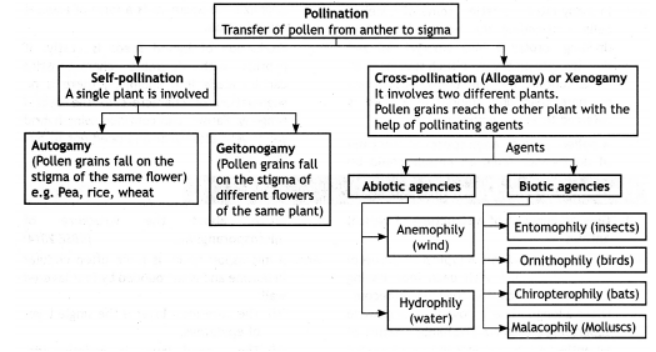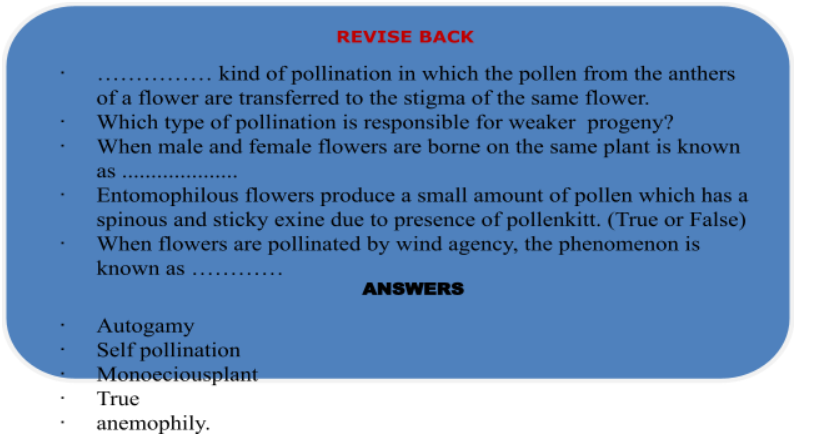
Pollination
How Do Organism Reproduce of Class 10
The process of transfer of pollen grains, from an anther to the stigma of the same flower or of different flower. It is of two types :
(1) Self pollination (2) Cross pollination

(1) Self pollination : This process involves the transfer of pollen grains from the anthers to the stigma of the same flower or of another flower borne by the same plant. It is of two types :
(i) Autogamy : It is a kind of pollination in which the pollen from the anthers of a flower are transferred to the stigma of the same flower.
(ii) Geitonogamy : It is an kind of pollination in which the pollen from the anthers of one flower are transferred to the stigma of another flower borne on the same plant. It usually occurs in plants which show monoecious condition (unisexual, male and female flowers are borne on the same plant). Geitonogamy involves two flowers but these belong to the same parent plant.
Merits
-
Pollen grains are not wasted.
-
The purity of the generation is maintained.
Demerits
-
New and healthier varieties are not formed.
-
It results in weaker progeny, producing weaker seeds and plants.
Contrivances for self pollination : The major contrivances or adaptations which favoursself pollination are :
(a) Bisexuality : Flowers should be bisexual or hermophrodite.
(b) Homogamy : Anthers and stigma of the bisexual flowers of some plants mature at the same time. They are brought close to each other by growth, bending or folding to ensure self pollination. This condition is called homogamy. e.g., Mirabilis (Four O, clock), Catharanthus (= Vinca), Potato, Sunflower, Wheat, Rice, etc.
(c) Cleistogamy : Some plants never open to ensure complete self-pollination. This condition is called cleistogamy, e.g., Commelinabengalensis, Oxalis, Viola, etc. The cleistogamous flowers are bisexual small, inconspicious, colourless and do not secrete nectar.
(2) Cross pollination : Cross pollination involves the transfer of pollen grains from the flower of one plant to the stigma of the flower of another plant. It is also called xenogamy.
Merits
- Seeds are more and viable.
- Progenies are healthier.
- Adaptability is better.
- New varieties can be produced.
Demerits
- The process is not definite because plants depend on agencies.
- Large amount of pollen grains are wasted.
Contrivances for cross pollination :Nature favours cross pollination. All unisexual flowers and a large number of bisexual flowers are naturally cross pollinated.
The main contrivances ensuring cross pollination are as follows :
- Diclincy or Unisexuality : In unisexual flowers stamens and carpels are found in different flowers. Unisexuality can be of two types :
- Monoeciousplant : When male and female flowers are borne on the same plant. e.g., Maize, Cucurbits, Castor.
- Dioeciousplant : When male and female flowers are borne on different plants. e.g., Carica papaya, Cannabis.
- Dichogamy : In bisexual flowers, when two sexes mature at different intervals and thus avoid self pollination is known as dichogamy. When stamens mature earlier than the stigma, it is known as protandry and the flowers are called protandrouse.g. Coriander, Jasmine, Sunflower, Lady’s finger, etc. When stigma matures earlier than the stamens, it is known as protogynyand the flowers are called protogynous. e.g., Rose, Tobacco, Crucifers, etc.
- Heterostyly : The plants of some species in which flowers are dimorphic. Thus facilitate cross pollination. Some of them possess a long style but short stamens and are known as pin-eyed while others have short style and long stamens. These are known as thrum-eyed. e.g., Oxalis.
- Herkogamy : In some bisexual flowers where the stigma and anthers mature at the same time, self pollination is avoided by some sort of barrier. The flowers show following contrivances :
- The male and female sex organs lie at some distance from each other.
- In some flowers corolla has peculiar forms which act as barrier in self pollination. e.g.Aristolochia.
- In some other flowers, the pollens are held together to form pollinia which can only be carried away by insects. e.g. Orchids and Calotropis.
- Self sterility or Incompatibility : When pollen grain of an anther do not germinate on the stigma of the same flower, then such flower is called self sterile or incompatibility and this condition of flower is called self sterility, intraspecific incompatibility or self incompatibility. In these flowers cross pollination is the only means for fertilization and production of seeds.
(3) Agents for cross pollination : Cross pollination involves external agents for the transfer of pollen grains of one flower to the stigma of another flower. There are two main groups of agents : (i) Abioticagents like wind and water
(ii) Biotic agents which include animals of different types such as insects, birds, bats, snails, etc.
(i) Abiotic agents
(a) Anemophily : When flowers are pollinated by wind agency, the phenomenon is known as anemophily. Wind pollinated flowers produce very large amount of pollen grains to compensate the wastage. Pollen grains of such plants are small, light, dry, and smooth. The female flowers have large feathery or brush like stigmas to catch the pollen grains. Anemophilous flowers are small and inconspicuous with long and versatile stamens. e.g. Sugarcane, Maize, Wheat, Bamboo, Pinus, Papaya, Grasses, Typha, Datepalm, Coconut, Mulberry, Chenopodium, etc. This type of pollination mainly observed in Graminae.
(b) Hydrophily : When the pollination takes place through the agency of water, it is known as hydrophily. All aquatic plants are not hydrophilous some are anemophilouse.g.Potamogeton, Myriophyllum or Entomophilouse.g.Alisma, Lotus. Hydrophily is of two types :
- Hypohydrophily :Plants which are pollinated inside the water e.g.Zostera, Ceratophyllum, Najas, etc.
- Epihydrophily :Plants which are pollinated outside the water. e.g.Vallisneria (Ribbon weed).
Biotic agents
(a) Entomophily : When pollination is brought about by the agency of insects, it is known as entomophily or insect pollination. About 80% pollination occurs by insects like moths, bettles, butterflies, wasp, etc. All the flowers pollinated by insects are brightly coloured, have a sweet smell and produce nectar. Entomophilous flowers produce a small amount of pollen which has a spinous and sticky exine due to presence of pollenkitt. The stigmas of such flowers are long rough and sticky. The insects visit the flower for nectar, edible pollen grain and shelter. Bees obtain both nectar and pollen grains from the flowers and have basket for collecting pollen. Salvia is excellent example of insect pollination is which pollination occurs by lever or turn pipe mechanism. Other examples of insect plants are Yucca (by Tageticula moth), Orchid Ophrys speculum (by Colpaaurea a hairy wasp), Ficus (by Blastophega), etc.
(b) Ornithophily : When flowers are pollinated by birds, the phenomenon is known as ornithophily. The most common bird pollinators are Sun bird, Humming bird, Crow, Bulbul, Parrot, Mynah, etc. The birds visit a large variety of flowers such as Bombax (red silk cotton), Erythrina (Coral tree), Callistemon (Bottle brush), Bignonia, Agave, etc. Flowers are brightly coloured and produce plenty of nectar and large quantities of pollen. Humming bird pollinates while hovering over the flowers and sucking nectar. The bird can derive about half of its body weight of nectar in a single day. The nectar is chiefly made of sugars and provides a sweet drink to the bird.
(c) Chiropterophily : It is a mode of pollination performed by bats. The flowers they visit are large, dull-coloured and have a strong scent. Chiropterophilous flowers produce abundant pollen grains. These flowers secrete more nector than ornithophilous flowers and open at night emit a good fragrance. e.g.Kigeliapinnata (Sausage tree), Adansonia (Baobab tree), Bauhinia megalandra, Anthocephalus (Kadam tree), etc.
(d) Malacophily : Pollination by slugsandsnails is called malacophily. Land plants like Chrysanthemum and water plant like lemna shows malacophily. Arisaema (aroid; snake plant) is often visited by snails.







